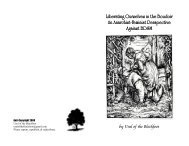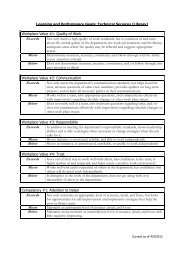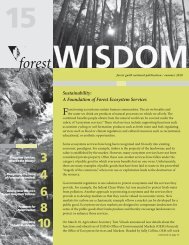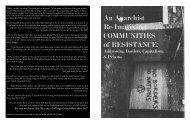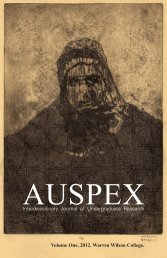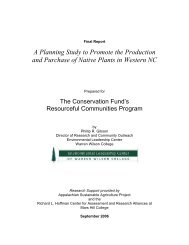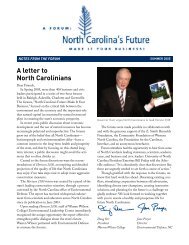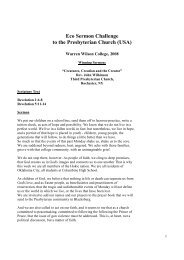Native American and Spanish Ancillary Structures - Warren Wilson ...
Native American and Spanish Ancillary Structures - Warren Wilson ...
Native American and Spanish Ancillary Structures - Warren Wilson ...
You also want an ePaper? Increase the reach of your titles
YUMPU automatically turns print PDFs into web optimized ePapers that Google loves.
from the posthole before deteriorating, the post mold<br />
will be less noticeable <strong>and</strong> may be completely gone due<br />
to the slumping of posthole fill into the post void. If<br />
the post was burned in place, sometimes the charred<br />
remains of the post will remain in-situ.<br />
Historical accounts provide insight into different<br />
ways posts were used <strong>and</strong> viewed by native people.<br />
<strong>Native</strong> <strong>American</strong>s viewed posts as functional (e.g.,<br />
roof support post) or symbolic (e.g., monumental post).<br />
Monumental posts, which are a type of symbolic post,<br />
are large posts erected in plazas, similar to flag poles<br />
we have today (Boudreaux 2007).<br />
One method of analyzing functional postholes<br />
is delineating them in the field (Benyshek et al. 2010).<br />
The first step in determining structure patterns is to<br />
identify postholes, which requires keeping detailed<br />
field records on all cultural, non-cultural, <strong>and</strong> possibly<br />
cultural postholes. South <strong>and</strong> DePratter (1996:77)<br />
distinguish posthole-sized pits at Santa Elena from<br />
definite postholes. They do not identify a postholesized<br />
pit as a posthole unless it is part of an identifiable<br />
structural outline or contains a post mold. Once<br />
the postholes are recorded on a computerized map,<br />
Benyshek et al. (2010) search for symmetry, alignment,<br />
<strong>and</strong> regular post spacing. Schroedl’s (1986) team at<br />
Chota-Tanasee depends on the presence of hearths <strong>and</strong><br />
regular post mold spacing of post molds with uniform<br />
depth, diameter, <strong>and</strong> fill that form a closed geometric<br />
pattern around the hearth to define structures. In 1974,<br />
Schroedl’s (1986:82) Chota-Tanasee team stopped<br />
excavating post molds, instead using a soil probe to<br />
discover post mold depth. Using these simple methods,<br />
the researchers are able to locate structure patterns.<br />
Methods<br />
In order to underst<strong>and</strong> the use of space in the<br />
miniplazas at the Berry site, I studied the postholes in<br />
these areas. I analyzed three dimensions of excavated<br />
postholes—size, shape, <strong>and</strong> color—using a quantitative<br />
coding instrument that characterizes postholes. I used<br />
my observations to classify postholes based on these<br />
dimensions (see below). I obtained data on the postholes<br />
from posthole excavation forms, unit excavation<br />
forms, feature forms, <strong>and</strong> maps, which the excavators<br />
completed at the time of excavation. Postholes with<br />
similar characteristics were analyzed by their location<br />
on the site map.<br />
The first of the three dimensions of postholes<br />
I examined was size. Posthole size includes measures<br />
of diameter <strong>and</strong> depth. All of these data were recorded<br />
on the posthole excavation form, unit form, feature<br />
form, or map, depending on the year of excavation. I<br />
divided the postholes into the categories of smallest,<br />
small, medium, <strong>and</strong> large based on their diameters. The<br />
smallest postholes were less than 10 centimeters across,<br />
small postholes were between 10 <strong>and</strong> 19 centimeters<br />
across, medium postholes were between 20 <strong>and</strong> 30<br />
centimeters, <strong>and</strong> large postholes were more than 30<br />
centimeters. Posthole depth was divided into shallowest<br />
(less than 10 centimeters deep), shallow (between 10<br />
<strong>and</strong> 19 centimeters deep), average (between 20 <strong>and</strong> 40<br />
centimeters deep), <strong>and</strong> deep (more than 40 centimeters<br />
deep).<br />
Identifying the shape of postholes is very<br />
important in determining the origin of the postholes. The<br />
two shapes it is important to distinguish are circular <strong>and</strong><br />
square, but in my analysis I divided them into circular,<br />
oval, square, rectangular, or irregular because those were<br />
the most common descriptors on the excavation forms.<br />
Any postholes that did not fit into these categories (e.g.,<br />
triangular) were treated individually.<br />
In addition to analyzing the shape of excavated<br />
postholes, I also analyzed the shape of some unexcavated<br />
postholes. Most unexcavated postholes do not include<br />
records of any of the information I need for my<br />
instrument, which is why I left most of them out of this<br />
part of my analysis, but these unexcavated postholes<br />
appeared square at the surface <strong>and</strong> were labeled<br />
“possible STP” (possible shovel test pit) on the unit<br />
maps. Although these postholes were included on the<br />
unit maps as possible STPs, they were excluded from<br />
the main site map because excavators assumed these<br />
were modern disturbances. I added these unexcavated<br />
square disturbances to the map <strong>and</strong> analyzed them<br />
alongside the excavated square postholes.<br />
The third dimension I analyzed was soil color<br />
which is recorded on the posthole excavation form<br />
or the posthole map. It is based on the excavators’<br />
observations, so is not completely reliable. I did not<br />
get the exact color of the soil, but I did have the color of<br />
the soil relative to the surrounding soil matrix. The soil<br />
can be a single color, like dark brown or dark grayish<br />
brown, or it can be mottled, containing multiple colors<br />
of soil.<br />
Some postholes that have multiple colors of soil<br />
contain post molds. Some researchers use the terms<br />
“posthole” <strong>and</strong> “post mold” interchangeably, but there<br />
is a subtle difference. A posthole is the hole that was<br />
dug to house a post; a post mold is a stain where the<br />
post actually stood. This can include burned posts




